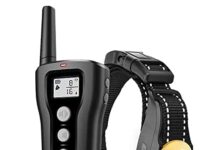In dog training tools, shock and vibration collars are commonly used to train and control our four-legged friends.
But what exactly is the difference between these two types of collars? This article will explore the contrasting features and effects of a dog shock collar versus a vibration collar.
Whether you’re a dog owner looking for the right training tool or simply curious about the methods and effectiveness of these collars, read on to better understand their differences and determine which one may be better suited for your furry companion.
Definition of Dog Shock Collar
A dog shock collar is a training tool that delivers a mild electric shock to a dog to correct undesirable behavior or reinforce training commands. It typically consists of a collar equipped with metal contact points that contact the dog’s skin when activated. These contact points deliver a static pulse that temporarily startles the dog and interrupts their unwanted behavior.
How Does a Dog Shock Collar Work?
When a dog engages in disobedient or unwanted behavior, such as excessive barking or jumping on people, the shock collar can be used as a deterrent. The collar is controlled by a remote or an automated device, allowing the owner or trainer to send a signal to deliver a static pulse to the dog. This pulse functions as an aversive stimulus, encouraging the dog to associate the unwanted behavior with an unpleasant sensation, thereby discouraging further occurrences.
Levels of Shock Intensity
Most shock collars come with adjustable shock intensity levels. This allows the owner or trainer to tailor the intensity of the shock to suit the dog’s behavior and temperament. Lower levels of shock are often recommended for smaller or more sensitive dogs, while higher levels may be necessary for larger or more stubborn breeds. It is important to note that shock collars should always be used responsibly and under a professional trainer’s guidance to ensure the dog’s safety and well-being.
Definition of Dog Vibration Collar
On the other hand, a dog vibration collar is a training tool that uses vibrations rather than electric shocks to modify a dog’s behavior. Like the shock collar, it is typically worn around the dog’s neck and can be controlled remotely or automated.
How Does a Dog Vibration Collar Work?
A vibration collar sends a gentle vibrating sensation to the dog’s neck when activated. This vibration serves as a distraction or mild aversive stimulus, redirecting the dog’s attention and discouraging unwanted behavior. It can be particularly effective for dogs that are sensitive or react negatively to electric shocks, providing an alternative training tool that is still effective in helping to shape their behavior.
Types of Vibration Patterns
Vibration collars often offer a variety of vibration patterns to suit different dogs and training needs. Some collars may have a continuous vibration mode, providing a steady and ongoing stimulation. Others may offer a pulsating vibration mode, which delivers intermittent or rhythmic vibrations. The choice of vibration pattern depends on the individual dog and the behavior being addressed. Experimentation and consultation with a professional trainer can help determine the most effective pattern for each specific dog.
Purpose of Using Shock or Vibration Collars
Both shock and vibration collars are tools that can be used for training and behavior modification in dogs. While they serve a similar purpose, there are essential considerations to remember when deciding which type of collar to use.
Training and Behavior Modification
The primary purpose of using shock or vibration collars is to train dogs and modify their behavior. These tools can effectively correct undesirable behaviors such as excessive barking, jumping, digging, or aggression. They provide a consistent and immediate consequence for the dog’s actions, helping them understand what behaviors are desired and what is not.
Safety Considerations
Safety is a crucial aspect to consider when using shock or vibration collars. It is essential to ensure that the collars are used appropriately and responsibly. Proper fit and placement of the collar and appropriate intensity levels can help minimize any potential discomfort or harm to the dog. Additionally, it is essential to follow manufacturer guidelines and consult a professional trainer to ensure the collar is used safely and humanely.
Stimulus Delivery Mechanism
Both dog shock and vibration collars deliver stimuli to modify behavior, but the nature of the stimuli differs.
Electric Shock
As mentioned earlier, when activated, dog shock collars deliver a mild electric shock to the dog. The shock is designed to startle the dog and interrupt their behavior, serving as a deterrent. The intensity of the shock can be adjusted based on the size and temperament of the dog, but it is crucial never to administer excessive shocks that could cause harm or distress to the dog.
Vibration
Dog vibration collars, on the other hand, use vibrations as their primary stimulus. When activated, the collar vibrates, providing a subtle sensation to the dog’s neck. This vibration acts as a distraction or aversive stimulus, redirecting the dog’s attention and discouraging unwanted behavior. The intensity of the vibration can typically be adjusted to suit the dog’s sensitivity and training needs.
Benefits of Using a Shock Collar
While shock collars may spark controversy among dog owners, certain benefits are associated with using them appropriately and responsibly.
Quick and Instant Response
One of the critical advantages of shock collars is their ability to provide a quick and immediate consequence for a dog’s behavior. Unlike other training methods that may rely on delayed feedback or rewards, the shock from the collar is instantaneous. It helps the dog immediately associate their actions and the consequences. This can be particularly beneficial when addressing behaviors that require immediate correction.
Effective for Training Unruly Dogs
Some dogs may exhibit persistent or challenging behavioral issues, such as excessive aggression or stubbornness. Shock collars can be practical training and behavior modification tools in these cases. The aversive stimulus of the shock helps deter the dog from engaging in unwanted behavior, allowing for more effective training and control over their actions.
Drawbacks of Using a Shock Collar
While shock collars can be practical training tools, there are potential drawbacks and risks associated with their use.
Potential for Negative Association
One concern with shock collars is the potential for dogs to develop negative associations with specific environments, people, or activities due to the aversive nature of the shock. If not used correctly, dogs may associate the shock with unrelated factors, leading to fear or anxiety. It is essential to carefully follow training guidelines and consult a professional trainer to minimize the risk of negative associations.
Risk of Physical Harm
Though shock collars are designed to deliver mild and safe electric shocks, physical harm is still possible if not used correctly. Excessive shocks or using shock collars on dogs with certain health conditions may risk the dog’s well-being. It is crucial to exercise caution and ensure responsible usage by referring to manufacturer instructions and seeking professional guidance.
Benefits of Using a Vibration Collar
Vibration collars offer a more gentle approach to dog training and behavior modification, providing several benefits for the dog and the owner.
Non-harmful and Gentle Approach
Unlike shock collars, which deliver electric shocks, vibration collars offer a non-harmful and gentle approach to training. The vibrations produced by these collars are designed to startle or distract the dog rather than inflict physical discomfort. This makes them a preferred choice for owners concerned about using aversive stimuli on their dogs.
Suitable for Sensitive Dogs
Some dogs may have a susceptible temperament, making them more susceptible to distress or fear caused by electric shocks. Vibration collars are an effective alternative for these dogs, offering a milder stimulus that is less likely to cause anxiety or discomfort. The gentle vibrations can redirect the dog’s attention and deter unwanted behavior without causing undue stress.
Drawbacks of Using a Vibration Collar
While vibration collars can be a valuable training tool, there are a few limitations and considerations to remember.
May Not be Effective for All Dogs
While vibration collars can be effective for many dogs, they may not work equally well for all individuals. Some dogs may require a more potent stimulus, such as an electric shock, to effectively modify their behavior. Factors such as the dog’s breed, temperament, and the severity of the behavior being addressed should be considered when determining the most appropriate training method.
Limited Intensity Options
Unlike shock collars that offer a range of intensity levels, vibration collars typically have limited intensity options. This can make it challenging to tailor the stimulation level to suit each dog’s specific needs. However, manufacturers often design vibration collars with adjustable intensity levels to accommodate a wide range of dogs, and consulting with a professional trainer can help determine the appropriate intensity for practical training.
Choosing Between Shock and Vibration Collar
When deciding between a shock collar and a vibration collar, it is crucial to assess your dog’s specific needs and consult a professional trainer.
Understanding Your Dog’s Needs
Consider your dog’s temperament, size, and the behavior you seek to modify. Some dogs may respond well to vibration collars, while others may require the aversive stimulus of electric shocks to learn and change their behavior effectively. Considering your dog’s characteristics will help determine the most appropriate training tool.
Consulting with a Professional Trainer
Professional trainers have extensive experience in dog behavior and training methods. Engaging the services of a professional trainer can help guide you in selecting the suitable collar for your dog and teach you how to use it properly. They can assess your dog’s behavior, provide specific training techniques, and monitor their progress to ensure the training methods are effective and humane.
Ethical Considerations
When using any training collar, including shock or vibration collars, it is essential to consider the ethical implications and use the tools responsibly.
Understanding the Purpose and Correct Application
Before using a shock or vibration collar, it is essential to understand its purpose and limitations. These collars should be used as training tools, not as a punishment or inflicting unnecessary discomfort on the dog. It is crucial to ensure the collars are used within appropriate intensity levels and with positive reinforcement techniques to create a positive learning environment for the dog.
Alternative Training Methods
While shock and vibration collars can be practical training tools, alternative methods are available. Positive reinforcement training, for example, focuses on rewarding desired behaviors rather than punishing unwanted ones. This approach is highly effective and often recommended as a primary training method. Additionally, seeking the guidance of a professional trainer can help explore alternative training techniques that may align better with your dog’s needs and your ethical considerations.
In conclusion, shock and vibration collars serve as training and behavior modification tools for dogs. Shock collars deliver electric shocks, while vibration collars provide gentle vibrations as a redirection.
Each type of collar has its benefits and drawbacks, and it is essential to choose the most appropriate collar based on your dog’s needs, consult with a professional trainer for guidance, and always prioritize the safety and well-being of your furry companion.




![Petrainer Dog Training Collar [100% Waterproof] Petrainer Dog Training Collar](https://mydogtrainingcollar.com/wp-content/uploads/2019/03/Petrainer-Dog-Training-Collar-218x150.jpg)




































